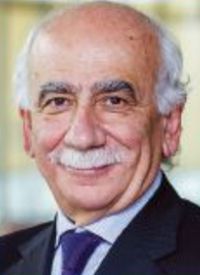Article
Optimal Upfront Lenalidomide/R-CHOP Use Remains Puzzle in DLBCL
Author(s):
Patients with activated B-cell-type diffuse large B-cell lymphoma with a poor prognosis may benefit from frontline treatment with lenalidomide plus standard R-CHOP, according to subgroup data from the phase III ROBUST trial presented at the 2019 International Conference on Malignant Lymphoma.
Umberto Vitolo, MD

Umberto Vitolo, MD
Patients with activated B-cell (ABC)-type diffuse large B-cell lymphoma (DLBCL) with a poor prognosis may benefit from frontline treatment with lenalidomide (Revlimid) plus standard R-CHOP, according to subgroup data from the phase III ROBUST trial presented at the 2019 International Conference on Malignant Lymphoma (ICML).1
In the overall ROBUST patient population, there was a not a significant improvement in progression-free survival (PFS) with the R2CHOP regimen of lenalidomide plus R-CHOP compared with R-CHOP alone. The median PFS was not reached in either arm (HR, 0.85; 95% CI, 0.63‐1.14; P = .29).
However, nonstatistically significant trends favoring R2CHOP were observed in subgroups of patients with disease stage III/IV (HR 0.81; 95% CI, 0.60‐1.10) and patients having an IPI score ≥3 (HR, 0.74; 95% CI, 0.53‐1.05).
“Overall, the ROBUST study did not meet the primary endpoint of PFS for lenalidomide/R‐CHOP versus placebo/R‐CHOP in previously untreated patients with ABC‐DLBCL, although a positive trend favoring lenalidomide/R‐CHOP has been observed in advanced stage and higher risk patients,” said Umberto Vitolo, MD, Città della Salute e della Scienza, University-Hospital, Torino. “Future direction of our study will be to evaluate the promising preclinical data of immunomodulatory agents in DLBCL.”
Vitolo explained that “Approximately one-third of patients with newly diagnosed DLBCL are of the ABC type, which is less likely to respond to standard therapies. Despite attempts to improve the outcome following R-CHOP by adding different agents, the ABC subtype of DLBCL continues to convey inferior survival, making a need to find new therapies.”
ROBUST was the first study to directly compare R2CHOP with placebo/R‐CHOP in patients with previously untreated, prospectively selected, CD20+ ABC‐type DLBCL. The study enrolled 570 adult patients with ABC‐DLBCL, Ann Arbor stage II to IV disease, IPI score ≥2, and ECOG PS ≤2.
All patients underwent an investigational gene-expression profile test to identify the gene of origin, specifically, patients with ABC-type DLBCL. Formalin-fixed paraffin-embedded excisional and surgical or core needle biopsy samples were analyzed by central pathology using the NanoString Lymphoma Subtyping Test based on the Lymph2Cx GEP assay. Within a mean turnaround time of 2.4 days, the investigators were able to establish the rates of ABC-type DLBCL rate among successfully tested samples as 60% from China/Japan/South Korea/Taiwan, 40% from Russia/Europe/Middle East, and 37% from North America/Australia/New Zealand.
Prior to randomization, the patients were stratified by IPI score (2 versus ≥3), bulky disease (<7 cm versus ≥7 cm) and age (<65 versus ≥65 years); 285 patients per arm were randomly assigned to receive 6 cycles of oral lenalidomide at 15 mg on days 1 to 14 or placebo, both administered with R-CHOP-21 (n= 285 per arm).
The primary endpoint was PFS assessed by independent central radiology per 2014 NHL IWG criteria, and defined as time from randomization to disease progression or death from any cause. Secondary endpoints included complete response (CR) rate, duration of response, time to next lymphoma treatment, objective response rate (ORR), event-free survival (EFS), overall survival (OS), and health-related quality of life.
In the overall population, analysis of the secondary endpoints also showed little difference between the 2 treatments. The ORR was 91% for both arms and the rates of CR were 69% with R2CHOP compared to 65% with placebo/R‐CHOP. EFS rates at 1 year were 68% versus 71% and 2-year EFS rates were 59% versus 61%, respectively. PFS rates at 1 year were 77% versus 75% and 2-year PFS rates were 67% versus 64%, respectively.
In the R2CHOP arm, 57 deaths occurred compared with 62 deaths in the placebo arm. The 1-year OS rates were 91% versus 90% and 2-year OS rates were 79% versus 80%, respectively. The median OS was not reached for either arm (HR, 0.93; 95% CI, 0.65-1.32; P = .64).
The most common grade 3/4 AEs occurring in ≥10% of for R2CHOP versus placebo/R‐CHOP were neutropenia (60% vs 48%), anemia (22% vs 14%), thrombocytopenia (17% vs 11%), leukopenia (14% vs 15%), febrile neutropenia (14% vs 9%), and lymphopenia (11% vs 8%).
With the respective treatments, 74% and 84% of patients completed 6 cycles of treatment. Treatment discontinuation was due to AEs (primarily neutropenia).
Vitolo’s presentation was immediately followed by discussion of the phase II ECOG-ACRIN 1412 trial, which, in contrast to ROBUST, demonstrated a positive improvement in PFS with R2CHOP versus R-CHOP in newly diagnosed patients with DLBCL and either ABC or germinal center B-like (GCB) subtypes.2 The 2-year PFS rate was 76% for the R2CHOP arm compared with 70% for the R-CHOP arm (P = .03).
Invited discussant, Margaret Shipp, MD, Dana Farber Cancer Institute, focused on the important differences between the 2 trials that may have produced the different results. Aside from the patient population, which was exclusively ABC subtype in ROBUST, and both ABC and GCB in ECOG-ACRIN 1412, the respective trials also used different dose levels of lenalidomide of 15 mg (days 1 to 14) versus 25 mg (days 1 to 10). She also highlighted that treatment was within 31 days of diagnosis in ROBUST, whereas patients were treated more rapidly—within 21 days—in ECOG-ACRIN 1412.
“Possible explanations for the different trial outcomes may include the different dose, eligibility criteria, and time to treatment,” Shipp concluded.
References
- Vitolo U. ROBUST: first report of phase III randomized study of lenalidomide/RCHOP (R2-CHOP) vs placebo/R-CHOP in previously untreated ABC-type diffuse large B-cell lymphoma. Presented at: 2019 International Conference on Malignant Lymphoma; June 18-22, 2019; Lugano, Switzerland. Abstract 005.
- Nowakowski GS. Addition of lenalidomide to R-CHOP (R2CHOP) improves outcomes in newly diagnosed diffuse large B-cell lymphoma (DLBCL): first report of ECOG-ACRIN 1412 a randomized phase II US Intergroup study of R2CHOP vs R-CHOP. June 18-22, 2019; Lugano, Switzerland. Abstract 006.









